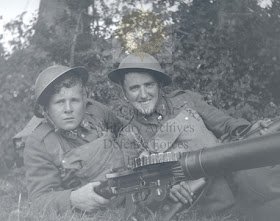Before we get started, Google "YouTube WWII and the Shameful Actions of Ireland". The short video gives background about Ireland's role in the Second World War and how Irishmen who chose to fight against Hitler were treated upon returning home.
Now for the walk around:
The liner is secured to the helmet shell by a large screw and nut
passing through the apex of the shell.
The liner is the first version of the mkII liner which utilizes fiber
rather than rubber bumpers on its perimeter.
The bumpers are fastened to the pressed paper crossbands
by split pins.
The liner's only marking is the numeral 7 appearing twice.
In addition to the fiber bumpers, the earlier version of the mk.II liner is characterized by a large pad at the crown.
The liner leaves are gathered by a cord.

The chinstrap bails are fastened with a single rivet. ROCo is the maker's mark for the firm of Rubery Owen & Co Ltd of Leeds. Also noted is that this is a mk.II helmet manufactured in 1940.
The rectangular chinstrap loops are held in place
with a tensioned clip.
The blackened brass buckle is overly complex and doesn't lend itself to quick fastening and unfastening.
The helmet rim is a separate piece of stainless steel spot welded along the edge of the shell and butt-joined at the rear of the helmet.
This marking is penciled under the brim. Initials "ER" perhaps?
The shield and six-pointed star is the insignia of
the Eastern Command.
And now, some photos of the helmet in action:
President of the Republic of Ireland Eamon DeValera reviewing the troops during "the Emergency".
Irish soldiers in Wexford inspect a creamery bombed by the Nazis in clear violation of Irish neutrality.
There you have it. I'll see you next time with another cool helmet from the collection.































No comments:
Post a Comment
Your comments are welcome and you can always email me at manniegentile@gmail.com with comments, questions, or corrections.